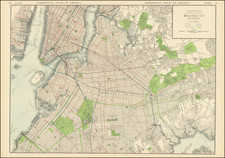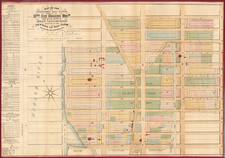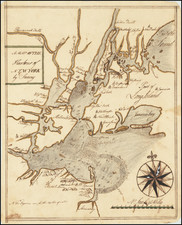One of the Earliest Obtainable Views of New York City
Scarce early view of Colonial New York City from Brooklyn Heights, first published in 1761, originally drawn by famed colonial birdseye view artist William Burgis.
The Burgis view is generally regarded as the earliest reasonably obtainable view of the city, showing the city as it appeared in the second decade of the 18th Century.
Shown on the eve of its growth following the French & Indian War and prior ot the American Revolution, the view shows the southern portion of Manhattan Island, with Battery and Fort George at the far left to the stockade at the far right which would become Wall Street.
Beginning in 1716, William Burgis stood at the Brooklyn Heights shore and drew the waterfront along the east side of Manhattan, calling it “A South Prospect of the Flourishing City of New York in ye Province of New York in America.” The drawing was sent to London, where John Harris engraved the image on four copper plates, which when printed and joined created a six foot wide panoramic view of the City, which was first advertised for sale in America in 1721 in The American Weekly Mercury as “A Curious Prospect of the City of New-York…”
The view was copied several times over the years, including the so-called 1746 “Bakewell reissue” and in 1761, a new impression engraved for the London Magazine.
The view locates 22 points of interest, including:
- Fort George
- Fort George Chapel
- The Secretary’s Office
- The Great Dock
- The Ruins of Whitehall, built by Governor Dongan
- Part of Nutten [later Governor’s] Island
- Part of Long Island (Brookyn)
- The Lower Market
- The Crane
- The Great Flesh-Market
- The Dutch Church
- The English Church
- The City Hall
- The Exchange
- The French Church
- Upper Market
- The Station Ship
- The Wharf
- The Wharf for building Ships
- The Ferry-House, on Long Island (Brooklyn) Side
- A Pen for Cattle, designed for the Market
- Colonel Morris’s Fancy, turning to windward, with a Sloop of common mould
States of the View
This is one of two editions of the 1761 edition of the view, which were printed with separate copper plates, with slightly different titles:
- "New York in North America."
- "New York in America"
While the two look nearly identical, there are many subtle differences, the most notable is that several of the sailing ships in the "New York in America" edition do not have people aboard, whereas all the sailing ships on the "New York in North America" edition include people aboard the ships.












![[Lower East Side / Manhattan] Map of Delancy's Farm Eastern Part.](https://storage.googleapis.com/raremaps/img/small/59384.jpg)
![[Upper East Side - Manhattan -- 79th Street to 93rd Street] Map of the Common Lands from 76th to 93rd Street Showing the Old Streets and Plots As Surveyed and Mapped in 1796, By Cassimer T. H. Goerck, City Surveyor and Resurveyed by Isaac T. Ludlam in 1822 (See Notes) And the Distance between those old Streets and our Present Streets Part 4](https://storage.googleapis.com/raremaps/img/small/61033.jpg)
![[ Tribeca Indenture ] 1790 Indenture Between Robert C. Livingston and Amos Laforgee For Lease of Property on Reade Street in New York City](https://storage.googleapis.com/raremaps/img/small/100514.jpg)